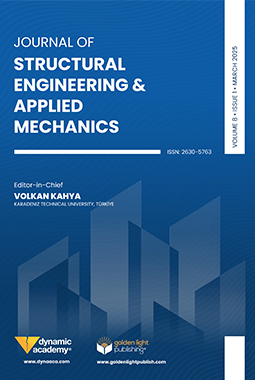ISSN:2630-5763
Journal of Structural Engineering & Applied Mechanics
ARTICLES
Abdullah Emül
Mostafa Ranjbar
A survey on current design and optimization of coupled-structural acoustic systems (OCSAS) is presented. It reinforces different terminologies and methods in this field. General concepts are shortly defined, and literature are reviewed for further investigation. Although surveys of optimization for coupled-structural acoustic systems are common, they are frequently incomplete in terms of extensive scope general applicability to engineering design. For instance, many surveys only target determined applications while others only mention the critical literature in the field. Outcomes are drawn that represent often-neglected ideas and applicability to engineering problems. It has been found that no single approach is outstanding. On the contrary, the selection of a determined method depends on the type of knowledge that is supplied in the problem, the user’s preferences, the solution necessaries, etc. Also, new emerging research fields are introduced.
https://doi.org/10.31462/jseam.2018.01041051
Yaprak ıtır Özdemir
The purpose of this paper is to study parametric earthquake analysis of thick plates resting on Winkler foundation using Mindlin’s theory, to determine the effects of the thickness/span ratio, the aspect ratio and the boundary conditions on the linear responses of thick plates subjected to earthquake excitations. In the analysis, finite element method is used for spatial integration and the Newmark-β method is used for the time integration. Finite element formulation of the equations of the thick plate theory is derived by second order displacement shape functions. A computer program using finite element method is coded in C++ to analyze the plates simply supported and clamped along all four edges. In the analysis, 8-noded finite element is used. Graphs are presented that should help engineers in the design of thick plates subjected to earthquake excitations. It is concluded that 8-noded finite element can be effectively used in the earthquake analysis of thick plates. It is also concluded that, in general, the changes in the thickness/span ratio are more effective on the maximum responses considered in this study than the changes in the aspect ratio.
https://doi.org/10.31462/jseam.2018.01052061
Murat Günaydın
Zeliha Tonyalı
Minarets are one of the specific structure types used commonly in Islamic Countries. Many minarets were damaged or collapsed during catastrophic events like earthquake. During an earthquake to understand the minarets’ behavior are so important since dynamic response of these structures depends on a detailed understanding of their structural characteristics, such as geometrical shape, supporting system, mode shapes, natural frequencies and modal damping ratio etc. This paper examines in detail a Turkish style reinforced concrete (RC) minaret, its finite element modeling, modal analysis and earthquake analysis. A reinforced concrete minaret which is generally built in Turkey is selected as an application. Three dimensional (3D) model of the minaret and its modal analysis are performed to obtain analytical frequencies and mode shapes using ANSYS finite element program. The minaret’s linear transient analysis is carried out using the 1992 Erzincan earthquake ground motion record to obtain the earthquake behavior of the minaret. At the end of the study, the calculated displacement responses and maximum-minimum principal stresses concentrations for the minaret are briefly discussed and illustrated.
https://doi.org/10.31462/jseam.2018.01062072
Murat Emre Kartal
The aim of this paper is to present accelerations and peak acceleration amplification coefficients in a concrete faced rockfill (CFR) dam. For this purpose, Torul CFR dam is considered by using finite element method. Hydrodynamic pressure of the reservoir water is considered modeled using the fluid finite elements based on the Lagrangian approach. Deconvolution of surface accelerograms is taken into account in numerical solutions. Geometric, material and connection non-linearity are considered in the finite element analyses. The Drucker-Prager model and the multi-linear kinematic hardening model are used for concrete slab and rockfill, respectively, in the materially non-linear analysis. Non-linear behavior of the rockfill is obtained by the uniaxial stress-strain relation. The stress-strain curve of the rockfill is obtained using the shear modulus-shear strain relation produced for the gravels. Different joints in the CFR dam are modeled with both welded and friction contacts. The friction in the joints is provided with contact-target element pairs based on the Coulomb’s friction law. The accelerations in the bottom and crest of the dam are compared each other since welded and friction contact in dam-foundation interface. Then peak acceleration amplification coefficients are also obtained compared each other. According to numerical comparisons, when the rockfill behaves materially non-linear, the maximum horizontal accelerations and peak acceleration amplification coefficients decrease in the crest.
https://doi.org/10.31462/jseam.2018.01073094
Alper Özmen
Erkut Sayın
Historical masonry arch bridges which are important components of the transportation in many places worldwide are invaluable part of architectural and cultural heritage. These bridges, which date back to hundreds of years, have frequently been damaged or ruined because of unexpected events such as earthquakes. In this study earthquake behaviour of a historical masonry arch bridge which called Dutpınar is analysed using 2003 Bingöl earthquake acceleration records. The bridge is modelled with three dimensional finite element software. Dynamic response of the bridge is investigated. For this purpose, displacement of the nodal point located at the top of the bridge is achieved. Also, maximum and minimum principal stress and strains are obtained and potential locations of initial damages are evaluated.
https://doi.org/10.31462/jseam.2018.01095104


